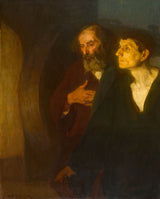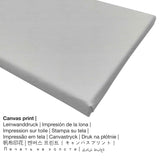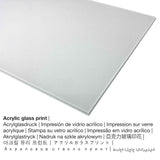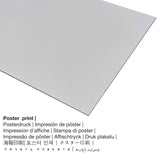Henry Ossawa Tanner, 1906 - The Two Disciples at the Tomb - fine art print
Tax included. Shipping calculated at checkout.
Information about the article
In 1906 the artist Henry Ossawa Tanner created the masterpiece. The piece of art had the following size - 129,5 × 105,7 cm (51 × 41 7/8 in). Oil on canvas was applied by the North American artist as the medium of the piece of art. The original masterpiece has the following inscription: signed, lower left: "H.O. Tanner". Furthermore, this work of art is in the the Art Institute Chicago's art collection. The modern art public domain artpiece is provided with courtesy of Art Institute Chicago. Additionally, the artwork has the following creditline: Robert A. Waller Fund. What is more, the alignment of the digital reproduction is in portrait format and has a ratio of 1 : 1.2, meaning that the length is 20% shorter than the width.
What would be your favorite product material?
The product dropdown menu ofers you the possibility to choose your prefered size and material. Choose among the following product options now to match your preferences in size and material:
- Poster (canvas material): The poster is a UV printed sheet of flat cotton canvas with a slightly rough structure on the surface, that resembles the actual masterpiece. Please note, that depending on the size of the poster we add a white margin of approximately 2-6cm round about the painting to facilitate the framing with a custom frame.
- Aluminium dibond print (metal): Aluminium Dibond prints are prints on metal with an impressive effect of depth - for a modern look and a non-reflective surface structure. A direct Direct Print on Aluminum Dibond is the ideal introduction to art reproductions on aluminum. The colors are bright and vivid in the highest definition, fine details of the print are crisp.
- Canvas: A canvas print is a printed cotton canvas mounted on a wood stretcher. A canvas makes the exclusive impression of three-dimensionality. Your canvas of this masterpiece will let you turn your custom art print into a large artwork as you know from art galleries. How do I hang a canvas on the wall? The great advantage of canvas prints is that they are relatively low in weight, which means that it is quite simple to hang the Canvas print without extra wall-mounts. Therefore, a canvas print is suited for all kinds of walls.
- The acrylic glass print: The print on acrylic glass, often denoted as a print on plexiglass, will convert the original artwork into beautiful décor. In addition, it forms a great alternative to dibond or canvas art prints. Your favorite artwork is being custom-made with state-of-the-art UV direct printing machines. The great advantage of an acrylic glass fine art copy is that contrasts and also small image details will be exposed with the help of the fine tonal gradation.
Legal disclaimer: We try what we can to depict the art products as closely as possible and to display them visually in our shop. At the same time, some pigments of the print products, as well as the print result might vary somehwat from the image on your device's screen. Depending on the settings of your screen and the nature of the surface, colors might not be printed as realisitcally as the digital version on this website. In view of the fact that all art prints are processed and printed by hand, there may as well be minor discrepancies in the motif's exact position and the size.
The product specifications
| Print categorization: | wall art |
| Method of reproduction: | reproduction in digital format |
| Production process: | UV direct printing (digital print) |
| Product Origin: | German-made |
| Stock type: | production on demand |
| Intended usage: | wall décor, wall art |
| Orientation of the image: | portrait format |
| Side ratio: | (length : width) 1 : 1.2 |
| Implication of image aspect ratio: | the length is 20% shorter than the width |
| Available choices: | acrylic glass print (with real glass coating), poster print (canvas paper), canvas print, metal print (aluminium dibond) |
| Canvas print (canvas on stretcher frame) variants: | 50x60cm - 20x24", 100x120cm - 39x47", 150x180cm - 59x71" |
| Acrylic glass print (with real glass coating) options: | 50x60cm - 20x24", 100x120cm - 39x47", 150x180cm - 59x71" |
| Poster print (canvas paper) size variants: | 50x60cm - 20x24", 100x120cm - 39x47" |
| Aluminium dibond print: | 50x60cm - 20x24", 100x120cm - 39x47" |
| Art print framing: | no frame |
Piece of art details
| Work of art name: | "The Two Disciples at the Tomb" |
| Artwork classification: | painting |
| Category: | modern art |
| Time: | 20th century |
| Year: | 1906 |
| Artwork age: | around 110 years old |
| Artwork original medium: | oil on canvas |
| Size of the original work of art: | 129,5 × 105,7 cm (51 × 41 7/8 in) |
| Artwork original signature: | signed, lower left: "H.O. Tanner" |
| Museum: | Art Institute Chicago |
| Museum location: | Chicago, Illinois, United States of America |
| Web URL: | www.artic.edu |
| Artwork license type: | public domain |
| Courtesy of: | Art Institute Chicago |
| Creditline: | Robert A. Waller Fund |
Artist details
| Artist: | Henry Ossawa Tanner |
| Other names: | Henry Ossawa Tanner, Tanner Henry Ossawa, Henry Owassa Tanner, Tanner Henri Ossawa, Tanner Henry Owassa, Tanner Henri, Tanner |
| Gender: | male |
| Artist nationality: | American |
| Professions: | painter, university teacher |
| Country of the artist: | United States |
| Artist classification: | modern artist |
| Died at the age of: | 78 years |
| Year born: | 1859 |
| Born in (place): | Pittsburgh, Allegheny county, Pennsylvania, United States |
| Year died: | 1937 |
| Place of death: | Paris, Ile-de-France, France |
© Copyright | www.artprinta.com (Artprinta)
(© Copyright - by Art Institute Chicago - Art Institute Chicago)
The Art Institute acquired The Two Disciples at the Tomb in 1906 after the canvas was declared “the most impressive and distinguished work of the season” at the museum’s annual exhibition of American painting and sculpture. At that time, Henry Ossawa Tanner was at the height of his reputation, enjoying international fame and winning prizes on both sides of the Atlantic. The son of an African American bishop, Tanner was raised in Philadelphia, where he studied with Thomas Eakins before working as an artist and photographer in Atlanta. Repelled by the racial prejudice he encountered in the United States, he chose to spend nearly all of his adult life in France.














